http://tuxgraphics.org/electronics

Temperature and humidity measurements with the AVR web-server
![[Illustration]](../../common/images2/article07091/title_sensirion.jpg)
Abstract:
The tuxgraphics Ethernet board has a lot of general purpose
IO pins where external hardware such as sensors can easily be
attached.
In this example we use the sensirion sht11 sensor to
- measure temperature
- measure humidity
- calculate the dew point
All that is done with just one sensor. No other external components
are needed.
_________________ _________________ _________________
|
The sht11
The sht11 from www.sensirion.com is a fully calibrated sensor. Not a single external component is needed to
use it in combination with an avr microcontroller.
It has:
- a wide supply voltage range (2.5-5.5V)
- 2 sensors for relative humidity and temperature
- Precise dew-point calculation possible
- Measurement range: 0-100% RH
- Absolute relative humidity accuracy: +/- 3% RH
- Temp. accuracy: +/- 0.4°C @ 25 °C
- digital output and fully calibrated sensor.
A datasheet is available in the download section of this article or from www.sensirion.com.
It is a very good quality sensor developed in Switzerland.
A few things are a bit misleading when you read the datasheet
of the sensor and I mention it here to avoid surprises:
- SHT11 has a 2-wire interface and that interface
is not identical to the atmel 2-wire interface (atmel TWI).
Atmel TWI is an I2C conform interface. The sensirion implementation
is not I2C conform. The main difference is in the start condition.
Sensirion does not say why they are not I2C conform. My personal opinion
is that they did that on purpose to avoid license issues with Philips
who developed I2C. The code needed communicate with the sensor is not
larger than code for an atmel TWI state machine. Therefore it does not really matter
that SHT11 is not I2C conform.
-
The sensor provides checksums to ensure integrity of all the measurement data.
The C-code example from Sensirion does not use that feature. I wanted
to use it and it took me some time to get it to work. The problem
was that Sensirion does not use standard CRC8 checksums. They use CRC8 with
the bytes bit-reversed.
What you need
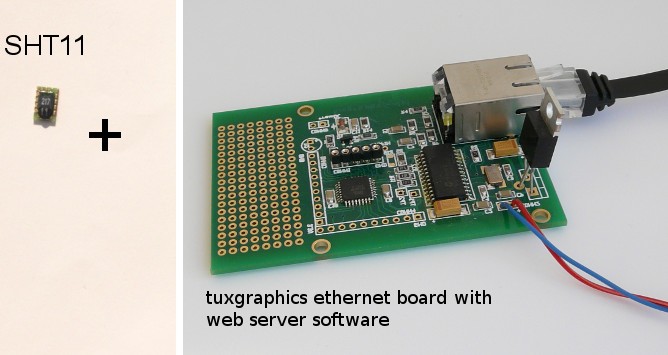
... and this is what you get (two sensors, s0 and s1, attached to the ethernet board):
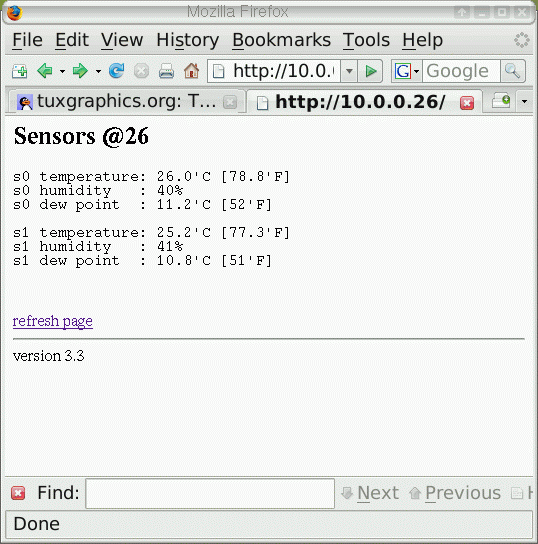
You can have one or more sensors attached to one ethernet board. The above web
page is an example with two sensors.
Humidity and temperature data accessible from any web-browser. Using
the NAT port forwarding feature in your DSL router you can
even make it available on the internet and access it e.g from your mobile phone:
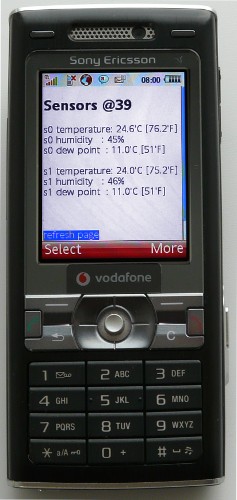
What is the dew point?
The dew-point temperature is the temperature to which the air must be cooled to
reach saturation. When the temperature
cools to the dew point, fog or dew can occur.
Example: In your bath room you measure 23'C and 61% humidity. The
resulting dew point is about 15'C. If your window or wall temperature
would be 15'C or less then it would become wet.
Connecting the sensor
The SHT11 humidity and temperature sensor can be connected
the Atmega microcontroller as follows. No additional components are needed.
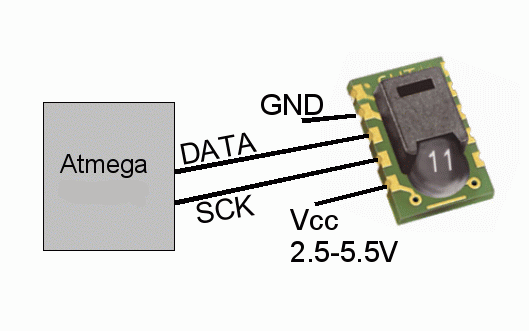
Nothing must be connected to pin 1 (at the top) and the pins on the right.
Those seem to be used for test and calibration during production.
You need just one more IO-pin per extra sensor in case you want to connect more than one sensor.
The sck line can be shared but each sensor needs its own
data-line as the sensors are all identical and can thus not be connected in a bus
system.
As of software version eth_rem_dev_sensirion-3.3 there is a possibility
to connect more than one sht11 sensor to one board. The sensor has to be connected as
follows:
| SHT11 | Web-server, new software (versions 3.3 and up)
|
|---|
| First sensor: |
| Vcc | 3.3V (available on the analog port or digital IO port) |
| Data | PD0 (available on the digital IO port) |
| SCK | PB0 (available on the digital IO port) |
| GND | GND (available on the digital IO port) |
| Second sensor (optional): |
| Vcc, SCK, GND | same as first sensor |
| Data | PD1 (available on the digital IO port) |
| Third sensor (optional): |
| Vcc, SCK, GND | same as first sensor |
| Data | PD4 (available on the digital IO port) |
It is possible to connect even more sensors.
The older software eth_rem_dev_sensirion-3.0, eth_rem_dev_sensirion-3.1 and
eth_rem_dev_sensirion-3.2 is designed to accept only one sensor which has to be
connected as follows:
| SHT11 | Web-server board with older software (versions 3.0, 3.1
and 3.2) |
|---|
| Vcc | 3.3V (available on the analog port or digital IO port) |
| Data | PD1 (available on the digital IO port) |
| SCK | PD0 (available on the digital IO port) |
| GND | GND (available on the digital IO port) |
My application
There are certainly plenty of applications for this. You can use it anywhere
where you want to measure any or all of the values temperature, dew-point and
humidity.
I just want to tell you what my use of it is. When I go on vacation I do
usually switch off the heating in the house to save cost. The problem with this
can be that it can either become too cold and/or too humid in the house. If
you leave a window open then it might become too cold. If you have the window
closed it can become very tropic (=too humid) due to the flowers in the rooms
and no ventilation.
With this sensor I can monitor the situation.
I can monitor that from my mobile phone or any computer at any time.
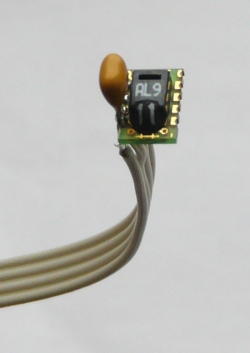
Sht11 with 100nf capacitor
|
Extending the sensor cable length
The length of the cable between microcontroller and SHT11 sensor should not be
more than 50cm to ensure reliable operation. You can however extend it to a 2-3
meters by soldering a 100nF capacitor between the power supply pins of the
sensor.
If you want to cover a whole building with humidity sensors then you can
just use a couple of ethernet boards with sensors attached to each of
them. Ethernet cables can be 100m long and this way a very
large area can be covered.
It is possible to make a number of ethernet boards, running
each their own web server software, available via only one DSL router
You need to configure different port numbers for the
different web servers and then setup port forwarding in the DSL router for
each of them. For this
you need to change the "#define MYWWWPORT" in file main.c. The setup could e.g
look like this:
| Internal IP and port | External URL |
|---|
| 192.168.0.10, web server port 80 | http://Your.Domain |
| 192.168.0.11, web server port 88 | http://Your.Domain:88 |
Automatically updating the web page
Personally I don't like web pages which reload themselves automatically.
Many people have however written to me that they would like to have such a
feature and maybe it makes sense here. You can leave the browser open and
it shows you always the current situation. As of software version 3.1 the page
updates every 5min. If you want additional updates in-between then you can just
click on the link "refresh page" at the bottom of the page.
The automatic page update is done by adding the http-refresh in the server header. The server header is part of
the http protocol and you don't see it if you click on page source in you
web browser. A refresh very 5min would look like this:
HTTP/1.0 200 OK
Content-Type: text/html
Pragma: no-cache
Refresh: 300
The corresponding avr web-server C-code would look like this (one line):
plen=fill_tcp_data_p(buf,0,PSTR("HTTP/1.0 200 OK\r\nContent-Type: text/html
\r\nPragma: no-cache\r\nRefresh: 300\r\n\r\n"));
References
© Guido Socher, tuxgraphics.org
2009-09-07, generated by tuxgrparser version 2.57
![[Illustration]](../../common/images2/article07091/title_sensirion.jpg)




